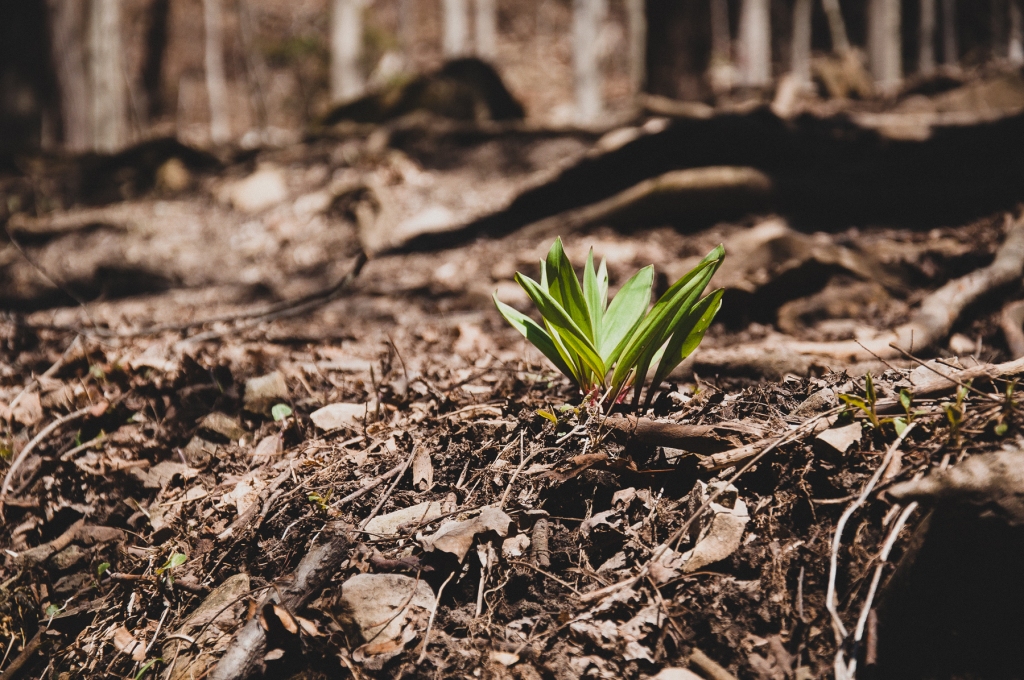When the warm weather started hanging around a couple of weeks ago, I went for a hike with my friend Jenna to see what wild edible food was sprouting. Ten minutes into our hike we stumbled across the first patch of wild leeks, also known as ramps or ramsons. I had a beloved spot where I had seen them in past years, but it was healthier than I remembered it! When you are searching for leeks in the forest, look for slopes which are facing the direction of mid-day sun. These little guys are eager for any warmth and sunlight once the ground thaws. They like being close to water sources or openings in the tree cover:


Sustainability is a factor when harvesting wild leeks. Over-harvesting is a real concern. It takes a few years for these plants to mature and produce seeds, so careful picking now means more for other people and future years of harvesting. They should be a few inches out of the soil and the stalk/bulb should be fairly large. Always pick no more than 5-10% of a patch, and leave the bulbs and roots in the ground by cutting them above the bulb with a sharp pocket-knife or pair of scissors. Try not to take more than you are able to use. The forest floor where we were was literally carpeted with them, so we chose one or two mature plants from each large patch.
Ramps are easy to identify once you know what you are looking for. Look for green leaves with purple/red stalks poking out of the ground. Their beautiful onion-y smell is a way to avoid confusion with other plants that may look similar. Ramps are in the same family as onion, leek and garlic known as the “allium” family. To me they are allium royalty, combining the best flavour components of all those plants: warm onion + garlic + leek flavour without any lingering acrid taste. Use them any way that you would use those ingredients!

When you bring your leeks home they can be stored uncleaned for days to weeks potentially, packed with paper towels in a plastic bag. Once they are washed they will deteriorate quickly. I wash them first in a large container of cold water, then rinse the outer layer off and carefully rinse in between the leaves where there is mud. It’s a meticulous job but really meditative and mindful too.

After the harvest was cleaned up the ramps were tossed into salads and omelettes, made into compound butter (recipe below) and also added into this fritatta. I sautéed zucchini, kale and ramps before adding them to the egg mixture along with some yummy Quebec soft cheese. Jenna turned hers into a yummy potato and leek soup!
A quick way to store your harvest for later use is to make pesto (blend leeks with olive oil and salt) to refrigerate or freeze, or make a compound butter:
1-2 cups wild leeks – chopped finely
1 lb unsalted butter – diced
Fleur de sel, to taste or other nice sea salt
Soften butter lightly at room temperature. Chop your leeks finely – using the greens and the stalk. Pat the chopped leeks with a paper towel to remove excess moisture. Mix the softened butter, chopped leeks and salt together until leeks are evenly distributed throughout the butter. Separate butter into 2 batches. Roll into a log on a piece of parchment, then roll the parchment around the log. (If butter is getting too soft place in the fridge or freezer until chilled) Wrap the parchment logs in saran wrap, then twist the ends to cinch the roll closed and create an even cylinder. Trim ends of saran wrap. Store refrigerated for a few days or freeze for a few months, tightly wrapped in saran wrap or in freezer bags. Serve with bread or melted on top of your favourite grilled meat/fish/vegetables as a quick delicious sauce option.
Want more foodundercontrol between posts? Follow me on social media for more photos and behind-the-scenes action!
instagram.com/lncharman
twitter.com/truffleandthyme
facebook.com/foodundercontrol
Happy foraging and cooking!
-Lauren Charman






Leave a comment